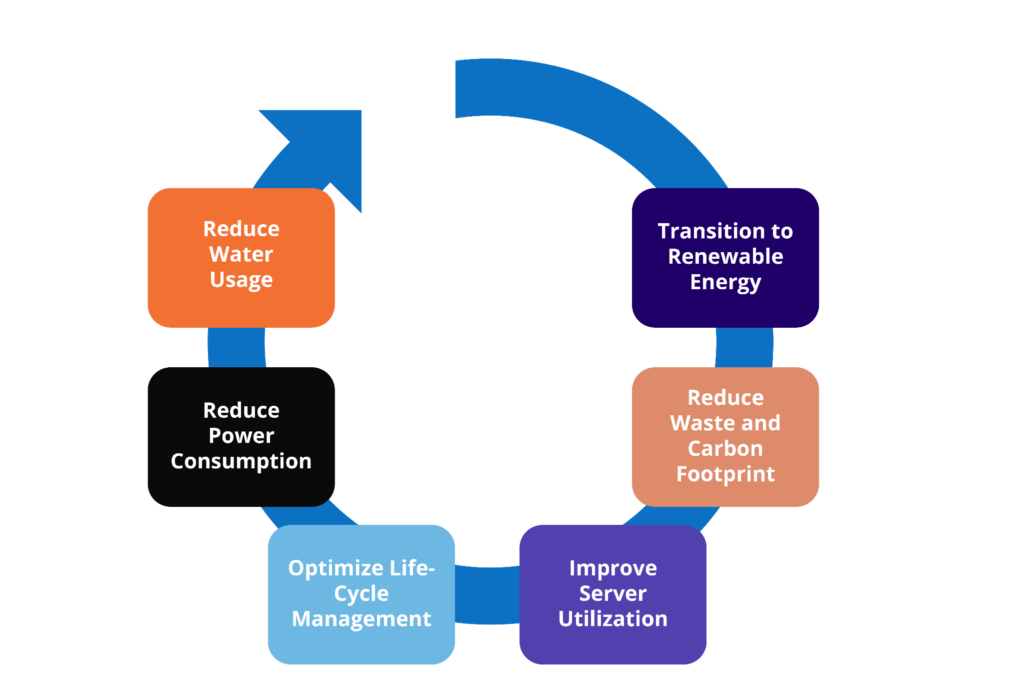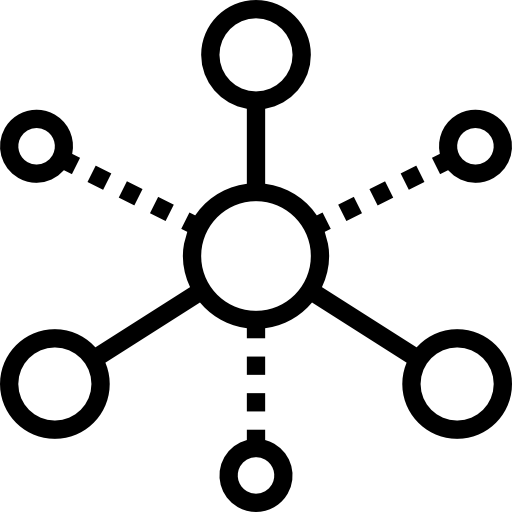Best Practices for Data Center Sustainability
Data centers presently account for almost 2% of global energy consumption. While concerns regarding the exponential growth of data center energy consumption have persisted for over a decade, hyperscale cloud service providers (CSPs) have effectively managed this issue in collaboration with industry vendors through the use of IT virtualization and the optimized utilization of power and thermal management infrastructure. Enterprises, which have historically been less efficient in managing data centers than CSPs, have also increasingly migrated their workloads and applications to the cloud.
However, the COVID-19 pandemic’s rapid acceleration of digital transformation led to a surge in data center demand, rekindling concerns about the future energy consumption of data centers. As a result, data center service providers’ customers, regulators, and investors are all demanding environmentally sustainable growth from the industry.
Data center sustainability is a tool for understanding the total cost of operations and a method to reduce these costs through innovation. The technological requirements associated with the maintenance and operations of a facility play a major role in determining the overhead and emissions associated with delivering data center services. This includes IT devices (processing and data storage systems), the underlying network grid utilized to transfer and maintain operational data, and the thermal and electrical systems utilized to run all of this equipment.
Summary of key data center sustainability concepts
| Sustainability defined | Sustainability is the practice of meeting present needs without compromising the ability of future generations to meet their own needs. |
| Sustainability cost model | The cost model for sustainability in data centers considers energy, personnel, and environmental costs to determine the overall financial impact. |
| Comprehensive sustainable practices from beginning to end | Data centers can implement sustainable practices throughout the planning, construction, and operation stages, ensuring environmental and resource efficiency. |
| Best practices for data center sustainability | Explore strategies like energy-efficient equipment, renewable energy adoption, and waste reduction to promote sustainability. |
| Summary of data center sustainability | The critical concept of data center sustainability is balancing current needs with future generations by implementing environmental and resource-efficient practices. |
Sustainability defined
In the pursuit of a more cost-efficient and ecologically sound operational model, the principles of sustainable design can be leveraged to meet key organizational goals. Regardless of the scale or scope of the problem, the benefits of incorporating sustainability into operations will have important implications on both the overhead and economic viability of an operational system. This is the case whether the choices for sustainability are applied to the selection of a new facility or improving an existing one.
At its core, data center sustainability can be described as both a perspective used to evaluate operating costs and as a process to optimize data center facility systems: sustainability as a metric and sustainability as a model for design.
The hardware and software systems required for data center operations rely on high-demand architectures both in terms of power usage and staffing resources. These include IT devices, processing and data storage systems, the underlying network grid utilized to transfer and maintain this operational data, and the thermal and electrical systems utilized to run everything.
Understanding sustainability as a metric, the net cost of operating these systems (both to the user and the environment) can be rationalized based on power consumption and carbon footprint. In this way, a facility and its constituent hardware can be described as more or less sustainable based on their net output compared to the emissions required to provide that output. Here, the notion of a cost analysis that incorporates emissions becomes a useful tool in evaluating the “actual” bottom line of operations.
Using the second definition of sustainability—the practice or principled design of key operational subsystems—the process of identifying sustainable alternatives depends on the critical requirements of a facility. These requirements will lead to a budget in terms of power, thermal capacity, and data management that can be used to gauge the success of sustainable practices.
Some examples of how information gathered to this end may serve to help promote the installation of new, energy-efficient alternatives could include:
- Lighting: Using LEDs instead of fluorescent bulbs
- Cooling: Using high-efficiency heat pumps instead of less efficient systems
- IT networks: Using virtualized or commercial cloud enterprise solutions
Understanding system requirements would drive the shift of key operational systems to ones that provide equal services without unsustainable overhead such as consumable fluorescent bulbs, the use of fossil fuels, and the hardware and staffing requirements associated with a physical data network instead of a cloud-based or virtualized alternative. Furthermore, the choice for sustainable design has implications on the training/upskilling of staff to meet the demands of a facility looking to lean into these new technologies.
Sustainability cost model
Data centers, in general, are businesses that must balance the cost of providing services with net profitability. The main factors in calculating cost are traditionally the cost of power and the cost of staff.
Power can be easily broken down into the energy requirements associated with the data center infrastructure: electrical, thermal, and networking. Similarly, the cost of staffing a data center can be broken down into the individuals needed to keep the systems operational: maintenance people, hardware specialists, and customer service staff.
However, when focusing on sustainability, there is a third factor that has become an increasingly significant liability in recent decades: environmental cost.
The cost to the environment associated with data center operations is a function of both the physical footprint of the data center and the energy requirements of the systems within it. Each of these factors can be calculated to determine the facility’s carbon footprint, which is a metric that assesses the total carbon required to build and operate a commercial system. This is true even in use cases where a new data center is not being constructed from the ground up but rather being modernized for great sustainability.
For example, the footprint of a particular facility might take into account the carbon cost of its constituent materials:
- Reinforced concrete: 635 kg of embodied carbon per m³
- Glass: 3,600 kg of embodied carbon per m³
- Steel: 12,090 kg of embodied carbon per m³
These values are taken as emission factors or CO2 equivalents, which, when combined with the more direct values associated with power consumption, can be used to determine the total or net footprint of a commercial enterprise.
The net footprint of a facility or business can directly affect the profitability of a data center because it may impact power utility rates and carbon-specific taxes levied against the total emissions. Additionally, the footprint of a facility may help organizations determine whether there is major waste negatively impacting the operational bottom line. This may drive important decisions in terms of specific service providers: choosing one data center facility over another, selecting one power utility over another, or deciding how expansion and growth opportunities fit into the larger organizational requirements of a business.
Choosing a data center
Choosing the right data center is crucial for businesses seeking to optimize their operations while ensuring sustainability.
One important consideration is the location of the data center. Opting for a facility in an area with access to renewable energy sources, such as wind or solar power, can significantly reduce the carbon footprint associated with the data center’s energy consumption. Additionally, proximity to renewable energy infrastructure can facilitate the integration of clean energy into the data center’s operations.
Another aspect to evaluate is the data center’s energy efficiency and utilization. Look for facilities that have implemented measures to optimize server utilization, such as virtualization technology, which allows for consolidating multiple virtual servers onto a single physical server. This approach improves energy efficiency by reducing the number of servers needed and, consequently, the total power required.
Also consider the data center’s commitment to sustainable practices and certifications. Look for certifications like Leadership in Energy and Environmental Design (LEED) or Energy Star, which demonstrate the facility’s adherence to rigorous sustainability standards. Such certifications indicate that the data center has implemented energy-efficient technologies, practices waste reduction and recycling, and minimizes its environmental impact.
Power utility carbon costs
The energy source powering a data center can significantly impact its carbon footprint and overall sustainability. Evaluating the carbon costs associated with the power utilities available to the data center is essential.
When selecting a power utility, consider its renewable energy portfolio. Opt for utilities with a higher percentage of energy generation from renewable sources, such as wind or solar.
Assessing the utility’s commitment to sustainability and environmental responsibility is also essential. Some power utilities may have initiatives to offset or reduce their carbon emissions. Research their sustainability goals, investments in renewable energy projects, and efforts to promote energy efficiency. By aligning with utilities with similar sustainability objectives, data centers can support the growth of renewable energy and contribute to a more sustainable energy grid.
Sustainable growth
Data centers’ rapidly increasing energy consumption and ecological impact highlight the need for sustainable growth. This encompasses energy efficiency, renewable energy use, waste elimination, and carbon emissions reduction. Data center businesses can implement various strategies to ensure sustainable growth.
First, prioritizing energy efficiency is crucial. Optimizing data center infrastructure can reduce energy consumption and minimize environmental impact.
Using renewable energy sources is also a significant factor supporting sustainable growth. Data centers can procure sustainable electricity from independent energy producers through long-term contracts or support their renewable energy projects.
Waste reduction and minimizing the carbon footprint are also integral to sustainable growth. Most of the waste generated by data centers can be recycled or converted back into nature through recycling and composting. Additionally, aligning the data center’s energy consumption with carbon-free energy sources in the region is possible.
Sustainable growth necessitates accepting and implementing environmental responsibility in the data center industry. Data center businesses should strive to increase energy efficiency, use renewable energy, and improve waste management. This way, they can progress toward sustainable growth, becoming enterprises that are both environmentally conscious and profitable.
Comprehensive sustainable practices from beginning to end
The planning, construction, and lifecycle management of data centers are inherently complex. Successful execution involves a wide range of considerations, including determining the appropriate size of the data center for the business, selecting which technologies to utilize, and deciding what type of data center to use (dedicated, colocation, etc.).
Trying to integrate sustainability into this process without raising costs or affecting reliability only increases the complexity. Nonetheless, with the aid of modern tools and technologies, enterprises and service providers can leverage best practices to design, build, operate, and maintain data centers in a way that optimizes sustainability.
Site selection and intelligent simulation
Managing data centers is a challenging task that requires expertise and careful planning. From choosing the appropriate size and location of the facility to determining which technologies to deploy, there are numerous factors that need to be taken into account. Additionally, integrating sustainability criteria into the planning process can be difficult, as it involves assessing the environmental impact of the data center and developing strategies to mitigate it without compromising reliability or incurring additional costs.
Fortunately, modern tools and technologies can assist enterprises and service providers in designing and managing sustainable data centers. By adopting best practices and leveraging innovative solutions, it is possible to reduce energy consumption, minimize waste, and increase the use of renewable energy sources. For example, implementing virtualization technology can improve server utilization rates, which can reduce the amount of energy required to power and cool the data center. Additionally, using advanced analytics tools can help identify opportunities to optimize energy usage and minimize environmental impact.
Sustainable data center operations and maintenance using DCIM
Data center infrastructure management (DCIM) software has undergone significant changes to emphasize sustainability as part of the operation and maintenance of data centers. Today’s versions are interoperable, proactive, and automated, thanks to the proliferation of sensors, centralized cloud services, and AI-driven automation. DCIM software, like Device42’s solution, collects and analyzes data to create action items, forecast future performance and failures, and automate efficiency improvements.
These enhanced DCIM software systems can have a significant impact on data center sustainability by optimizing power usage effectiveness (PUE), reducing energy consumption, simplifying equipment maintenance, automating asset discovery, and increasing capacity usage. These benefits can lead to lower electricity costs, decreased greenhouse gas (GHG) emissions, increased reliability, and lower total cost of ownership (TCO) for a data center.
DCIM software empowers operators to track energy consumption, identify high-usage areas, and detect inefficiencies by providing real-time monitoring, predictive maintenance, and reporting features. This information allows them to implement proactive measures to optimize power usage, reduce energy waste, and improve the overall energy efficiency of the data center.
DCIM software also helps operators enhance their cooling systems by providing insights into temperature variations, airflow patterns, and cooling efficiency. Armed with this information, operators can fine-tune cooling infrastructure, implement containment strategies, and optimize the operations of cooling equipment. These measures improve cooling efficiency, reduce energy consumption, and contribute to sustainable operations.
Resource utilization, asset lifecycle management, monitoring, and reporting
Efficient resource utilization is a critical factor in data center sustainability, and DCIM software assists in achieving this goal. By monitoring and analyzing resource utilization data, operators can effectively identify underutilized equipment, consolidate workloads, and plan for future growth. This optimization minimizes waste, reduces energy consumption, and supports sustainable resource management.
Effective asset lifecycle management is another area where DCIM software proves beneficial. By providing centralized visibility and control over assets, operators can track the lifecycle of each device, including energy usage, maintenance schedules, and end-of-life planning. This allows for efficient equipment utilization, reduces electronic waste, and promotes responsible disposal or recycling practices.
The real-time monitoring and predictive maintenance capabilities of DCIM software enable administrators to detect potential equipment failures or malfunctions. The software can predict and alert operators about impending issues by continuously monitoring equipment health, performance, and environmental conditions. This proactive approach allows for preventive maintenance, minimizes downtime, and reduces energy waste.
DCIM software provides comprehensive reporting capabilities for sustainability initiatives. It generates detailed reports on energy consumption, carbon emissions, and environmental impact, allowing data centers to assess their sustainability performance, measure progress, and demonstrate compliance with regulatory standards and certifications. These reports provide transparency to stakeholders, customers, and regulatory bodies, promoting sustainability practices and accountability.
Best practices for data center sustainability
The following best practices are key approaches to promoting data center sustainability. They encompass the adoption of renewable energy sources, reduction of water consumption and carbon emissions, enhancement of server and IT equipment utilization, and optimization of data center equipment lifecycle management. The successful implementation of these measures can enable cloud service providers and other data center operators to attain their sustainability objectives.

Best practices in data center sustainability
Reduce greenhouse gas emissions
Follow these steps to reduce GHG emissions and thus enhance sustainability.
Transition to renewable energy
- Establish long-term contracts with independent power producers to procure sustainable electricity.
- Engage in on-site investment initiatives for the development of renewable energy projects.
Reduce waste and carbon footprint
- Attain Total Resource Utilization and Efficiency (TRUE) certification (previously referred to as Zero Waste certification), which means that over 90% of the waste produced by the data center is diverted toward recycling or composting.
- Redirect waste generated by global data center operations away from landfill disposal.
- Incorporate construction methods like prefabrication to minimize waste during the data center’s building process while facilitating faster time to market.
- Align the electricity consumption of the data center with carbon-free energy sources available in the region.
- Employ heat recycling by harnessing the heat that a data center generates to supply neighboring public sector, residential, and commercial customers with a cost-effective and environmentally friendly heating source.
Reducing the data center’s carbon footprint begins with accurately calculating it. To do so, you can follow a few general steps, as laid out in the following example.
Suppose you have a data center that consumes 1,000,000 kWh of electricity per year. You obtain the emissions factor from your electricity provider, which is 0.5 kgCO2e/kWh.
Electricity-related emissions = Electricity consumption * Emissions factor = 1,000,000 kWh * 0.5 kgCO2e/kWh = 500,000 kgCO2e.
Now, let’s assume that the direct emissions from backup generators are 50,000 kgCO2e, cooling emissions are 150,000 kgCO2e, and server emissions are 200,000 kgCO2e.
Total emissions = Electricity emissions + Direct emissions + Cooling emissions + Server emissions = 500,000 + 50,000 + 150,000 + 200,000 = 900,000 kgCO2e.
The data center’s carbon footprint in this example is 900 metric tons of CO2e per year.
Improve server utilization
- Accelerate the implementation of converged infrastructure solutions to optimize the allocation of computing and storage resources in multi-tenant environments, improving operational efficiency.
- Embrace innovative server architectures that integrate new interfaces, like Compute Express Link (CXL), to facilitate the sharing of memory resources across a distributed network of servers.
- Implement advanced computing platforms, including graphics processing units (GPUS) and data processing units (DPUs), to enhance the efficiency of processing specific workloads.
Optimize lifecycle management
- Adopt circular economy principles to promote the reuse of components for server upgrades and retrofits, minimizing waste and maximizing resource efficiency.
- Conduct in-house reliability studies to prolong the operational lifespan of data center equipment, optimizing its usefulness and reducing the need for premature replacements.
- Manage server and other equipment end-of-life by reselling equipment in secondary markets.
Improve data center power usage effectiveness (PUE)
The current standard for measuring data center efficiency is power usage effectiveness (PUE), which compares a data center’s total power consumption to its IT equipment’s power usage. While PUE serves as a general indicator of sustainability, it has limitations. Its simplicity has allowed data centers to improve efficiency without addressing more significant sustainability issues: For example, adding more internal server fans may improve PUE but consume more energy overall.
Furthermore, PUE does not consider water consumption, which has increased due to adopting evaporative heat rejection technologies in data centers. As a result, there is a need for more comprehensive metrics that address these sustainability concerns, as described below.


In this alternative representation of the data, the power consumption of servers or data centers is analyzed based on its usage. Interestingly, in smaller applications, more power is dedicated to cooling than actual computation. However, in hyper-scale data centers, over 80% of the energy is allocated to IT components such as servers, networking, and storage, while only 13% is utilized for cooling purposes.
Presenting the data in this manner emphasizes the significant shift in power allocation at larger-scale data centers, where most of the energy is directed toward the core IT infrastructure rather than cooling systems. This highlights the efficiency and optimization of hyper-scale data centers in maximizing power consumption for computational tasks while minimizing energy usage for cooling.
Follow these specific steps to enhance PUE:
- Employ liquid and immersion cooling techniques to enhance thermal management in data centers, reducing server power consumption and improving energy efficiency.
- Implement and optimize ambient cooling wherever possible.
- Deploy servers equipped with customized ARM processors to enhance performance per watt, thereby maximizing energy efficiency.
Improve data center water usage effectiveness (WUE)
As mentioned above, to address the limitations of PUE in measuring data center sustainability, another metric called water usage effectiveness (WUE) has been developed. WUE is designed to measure the efficiency of water usage relative to IT equipment energy consumption. It provides a standalone metric to evaluate how effectively water is utilized in data centers.
The calculation for WUE considers the annual water usage in liters divided by the IT equipment energy consumption in kilowatt-hours. WUE offers a standardized metric for customers to compare data center service providers and make informed decisions based on their specific criteria.

These suggestions can help optimize WUE:
- Implement rainwater harvesting systems and condensate reclamation methods to capture and utilize water resources in the data center, promoting water conservation and sustainability.
- Emphasize the adoption of direct evaporative cooling systems over indirect evaporative systems to improve energy efficiency and reduce the environmental impact of data center cooling operations.
Summary of key concepts
The journey toward data center sustainability has only just begun. The magnitude of the sustainability challenges may appear daunting, but it also presents numerous opportunities for innovation in data center managers reaching their desired objectives.
The data center industry has the potential to lead the way, becoming not only one of the first but also the foremost sector to establish ambitious sustainability goals. These goals range from attaining carbon neutrality and sourcing 100% renewable energy to eliminating waste. By accomplishing these objectives, the data center industry can establish a comprehensive sustainability framework as a blueprint for other sectors to emulate.
To realize our collective goals, we must harness the power of collaboration. One of the most crucial initial steps involves the data center industry’s commitment to defining, establishing, and standardizing sustainability criteria and metrics for reporting. Sustainability must transcend mere marketing strategies and be rooted in accountability and decisive action.
We urge you to actively seek partnerships and initiate discussions to contribute to the collective knowledge and progress in sustainable data center development. By doing so, we can work together to build a greener, more sustainable future for the data center industry and beyond.




